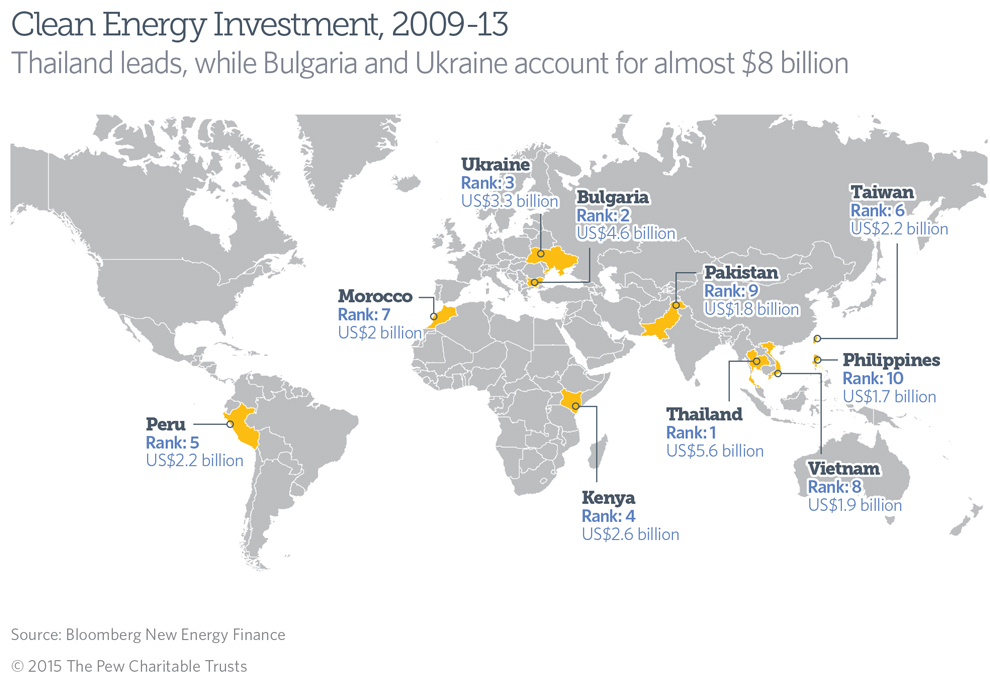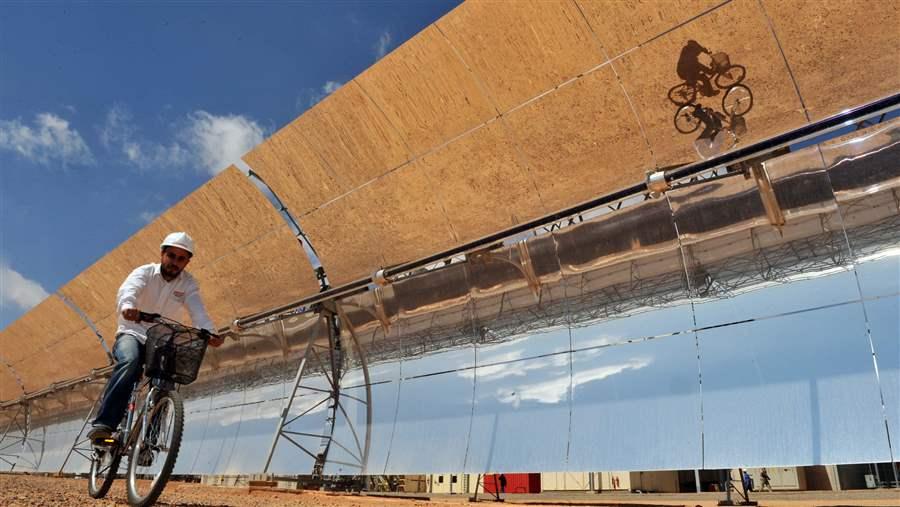Power Shifts
Emerging clean energy markets
For the last five years, the Pew Charitable Trusts’ report series "Who’s Winning the Clean Energy Race?" has tracked clean energy investment, finance, and deployment trends in the world’s leading economies—those that comprise the Group of 20. During that span, a global recession, broad changes in energy markets, and uncertainty surrounding international policies on renewables and climate change have buffeted the industry. Despite these challenges, the clean energy sector is now a $300 billion fixture of the world economy.
Pew’s research has found that clean energy investment in developing countries has grown in real and relative terms. The scale and scope of renewable investment and deployment are expanding in emerging economies in response to national economic development goals, local priorities for the environment and health, and international cooperation to reduce global energy poverty.
This report examines why and where clean energy is expanding in key markets of developing countries. It includes projections for investment and deployment of electric generating capacity through 2030 in both developed and developing markets.
EXECUTIVE SUMMARY
The world’s energy dynamic is changing in response to powerful economic, security, and environmental forces. Investment in and deployment of electricity infrastructure is shifting from the industrialized economies of the Northern Hemisphere to the emerging economies of the “global south”—developing nations that tend to be disproportionally concentrated in the Southern Hemisphere—and from conventional fossil fuels toward advanced clean energy technologies.
The Pew Charitable Trusts’ report series Who’s Winning the Clean Energy Race? has tracked clean energy investment, finance, and deployment trends in the world’s leading economies—those that comprise the Group of 20—since 2009.1 During that span, a global recession, broad changes in energy markets, and uncertainty surrounding international policies on renewables and climate change have buffeted the industry. Despite these challenges, the clean energy sector is now a $300 billion fixture of the world economy.
The overwhelming majority of worldwide clean energy investment occurs in the Group of 20—the world’s largest economies, such as China, the United States, the European Union, Japan, India, and Brazil. Together, the G-20 accounted for more than 90 percent of global clean energy investment over the past decade.
At the same time, however, Pew’s research has found that clean energy investment in developing countries has grown in real and relative terms. The scale and scope of renewable investment and deployment are expanding in these emerging economies in response to national economic development goals, local priorities for the environment and health, and international cooperation to reduce global energy poverty.
This report examines why and where clean energy is expanding in key markets of developing countries. It includes projections for investment and deployment of electric generating capacity through 2030 in both developed and developing markets. Finally, examining the five-year period from 2009 to 2013, this analysis identifies the top 10 emerging markets from among the 100 countries that are not members of either the G-20 or the Organization for Economic Cooperation and Development (OECD)2—the world’s developed economies—and examines clean energy trends in developing nations. The key findings include:
Developing countries are likely to account for two-thirds of demand growth to 2030
Most of the future increase in energy demand will occur in the global south as developing nations seek to meet international goals to reduce energy poverty and keep pace with population growth. Because of this rising demand, developing nations will need to significantly increase their energy supplies. These countries are projected to account for more than two-thirds of all new global energy capacity over the next decade and a half. In total, non-OECD countries will add more than 4,100 gigawatts by 2030, resulting in about 7,000 GW—a nearly 150 percent increase over today’s 2,800 GW.
Renewable energy will supply the majority of worldwide power capacity added through 2030
In view of its economic, security, and environmental advantages, clean energy is likely to play a major role in meeting the energy needs of developing countries. From 2013 to 2030, Bloomberg New Energy Finance projects, more than 5,570 GW of electricity capacity may be added globally. Renewable technologies are likely to supply 54 percent, or 3,000 GW, of total new capacity compared with less than 30 percent—1,584 GW—from fossil sources. Hydropower is on track to deliver 11 percent, and nuclear power is likely to fulfill 5 percent of the electricity generation added globally through 2030. In line with these trends, the data suggest that clean energy could attract more than two-thirds of the $7.7 trillion worth of expected power investment over the same period.
Clean energy investment in emerging economies is small but growing
Strong investment flows have fueled the recent rise of clean energy deployment and associated price reductions across renewable energy sources. From 2009 to 2013, countries outside the G-20 attracted 6.6 percent, or $75 billion, of the $1.13 trillion in worldwide private investment in the clean energy sector. But the share of investment in these countries has increased rapidly in both real and relative terms. In 2011, clean energy investment in developing nations totaled $13.8 billion, or 5.8 percent of the global total. By 2013, that figure had increased to $16.7 billion, 8 percent of the global total. These emerging markets have helped offset some of the impact of reduced investment in developed economies, such as Germany and Spain.
10 nations lead the new emerging markets for clean energy
Reflecting the growing demand for energy and investment in advanced technologies, 100 countries outside the G-20 and the OECD attracted $62 billion worth of clean energy investment from 2009 to 2103. Much of it occurred in a relatively small number of countries: Almost half (45 percent) of the total five-year investment, $27.9 billion, occurred in 10 emerging markets. Nations in the top 10 span four continents, but half are located in East and Southeast Asia. Thailand is the leading market, attracting $5.6 billion over the five-year period. Bulgaria and Ukraine account for almost $8 billion, garnering $4.6 billion and $3.3 billion, respectively. Kenya is fourth with $2.6 billion, and Peru is fifth with $2.2 billion. Taiwan, Province of China; Morocco; Vietnam; Pakistan; and the Philippines round out the list.
Solar attracts the most investment in emerging markets
The solar industry led all renewable sectors, attracting $12 billion, or 43 percent, of total clean energy investments in the top 10 markets from 2009 to 2013. Thailand and Bulgaria accounted for the most, with more than $3 billion each for large-scale solar installations of more than 1 megawatt in size. The wind industry reaped the second-greatest sum at $7.7 billion invested. Every country in the top 10 received wind project investments, led by Pakistan, Bulgaria, and Ukraine, which each attracted more than $1 billion. Together, solar and wind represented more than 70 percent of all investment, accounting for 43 percent and 28 percent, respectively.
Other renewables also garnered significant investment. More than $2.2 billion was invested in the biofuels and geothermal sectors. Kenya drew almost all of the geothermal investment, while Peru and Thailand each realized more than $600 million for biofuels projects. Vietnam led in the small hydro category, bringing in $1.2 billion of the nearly $2.1 billion total invested in this sector.
Growth of clean energy capacity outpaced that of conventional technologies in the top 10 emerging markets from 2009 to 2013
Conventional fossil energy continues to represent the majority of installed energy capacity in the top 10, with 67 percent of the total. However, deployment of fossil fuel-powered plants grew by less than 10 percent from 2009 to 2013. Over the same period, clean energy capacity in the top 10 countries grew by 91 percent, three times faster than any other supply option.
Every one of the top 10 emerging market countries added wind, solar, biomass, geothermal, or small hydropower capacity from 2009 to 2013, and seven added large hydro installations. In contrast, only five added fossil fuel technologies, and just one built more nuclear power.
Among renewables, installed solar power capacity grew the most across the top 10 emerging markets. Six countries placed an additional 3 GW of solar into service from 2009 to 2013, with Bulgaria (955 MW), Thailand (808 MW), and Ukraine (780 MW) accounting for the bulk of these gains. These same countries also accounted for much of the new wind turbine construction. Eight of the 10 countries installed wind energy (1.8 GW). Small hydropower capacity grew by 649 MW across seven countries, much of it in Vietnam. Thailand led the increase of 481 MW of biomass production, and Kenya accounted for nearly all of the additional geothermal plants.
Energy poverty is driving attention and resources to emerging economies
Efforts by countries outside the G-20 seeking to alleviate energy poverty, fuel economic progress, and protect the environment mean a promising long-term future for clean energy investment and deployment. According to the United Nations, more than 1.3 billion people are “energy poor,” lacking access to modern electricity services, with the overwhelming majority located in two regions, sub-Saharan Africa and Asia.











